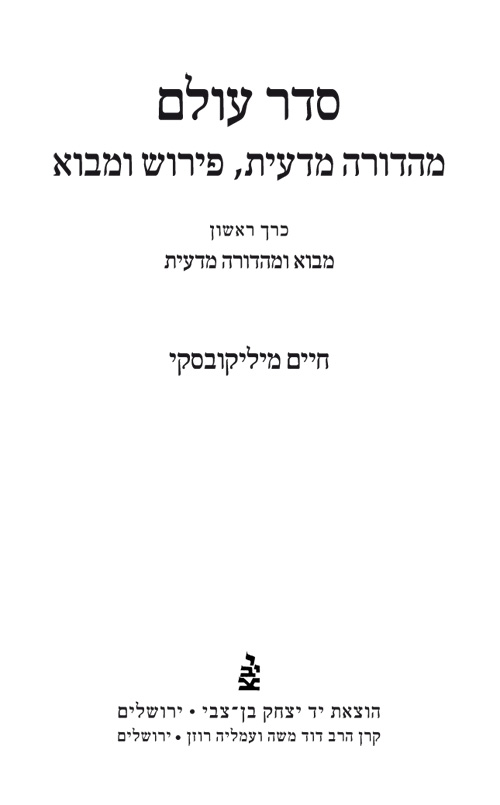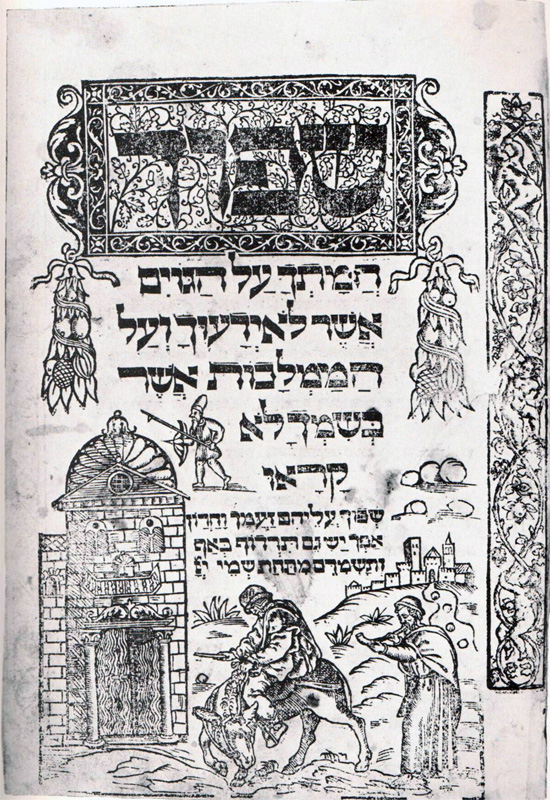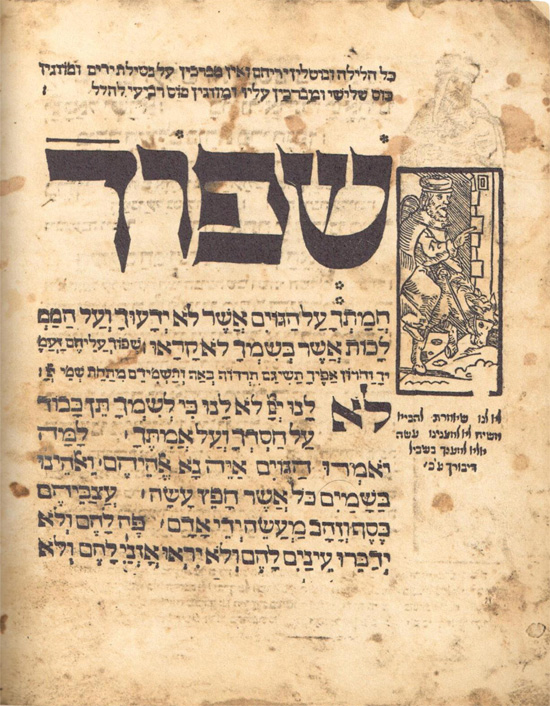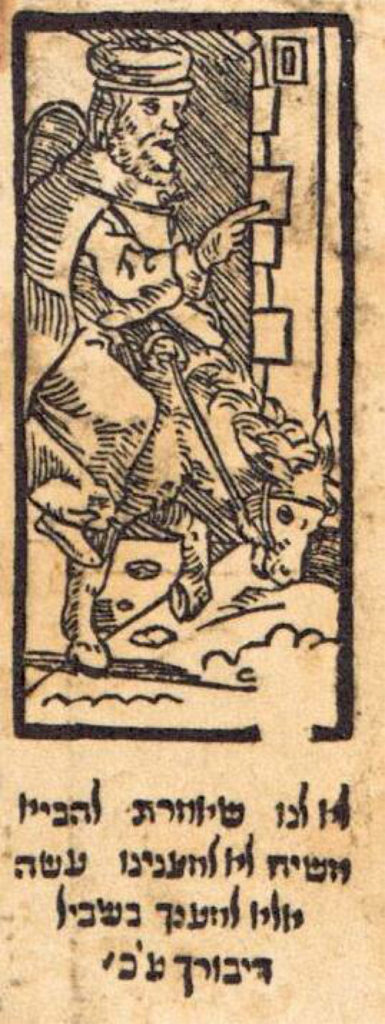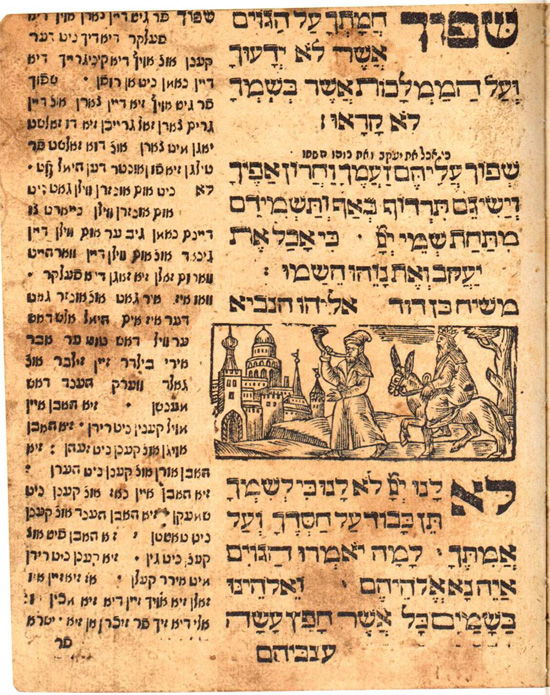Book
week 2013
By:
Eliezer Brodt
Book week just began in
Eretz Yisrael. As I have written in previous years every year in Israel, around
Shavous time, there is a period of about ten days called
Shavuah Hasefer – Book
Week (see
here,
here here,
here here and
here). Many of the companies
offer sales for the whole month.
Shavuah HaSefer is a sale which takes
place all across the country in stores, malls and special places rented out
just for the sales. There are places where strictly “frum” seforim are sold and
other places have most of the secular publishing houses. Many publishing houses
release new titles specifically at this time. In my reviews I sometimes include
an older title if I just noticed the book. As I have written in the past, I do
not intend to include all the new books. Eventually some of these titles will
be the subject of their own reviews. I try to include titles of broad interest.
Some books I cannot provide much information about as I just glanced at them
quickly. Some books which I note, I can provide Table of contents if requested,
via e mail.
As this list shows
although book publishing in book form has dropped greatly worldwide, Academic
books on Jewish related topics are still coming out in full force.
I have also included
some academic books that came out this year but are not being sold at
book week.
Additionally this year I
am offering a service, for a small fee to help one purchase these titles (or
titles of previous years). For more information about this email me at
Eliezerbrodt-at-gmail.com. Part of the proceeds will be going to support the
efforts of the the Seforim Blog.
א. אנציקלופדיה של
הסיפור היהודי, כרך ג.
ב. רש”י ובית
מדרשו, עורך א’ כהן, 264 עמודים [כולל חומר חשוב]
ג.
אוריאל
סימון, אזן מלין תבחן, מחקרים בדרכו הפרשנית של ר’ אברהם אבן עזרא 557 עמודים
[מצוין].
ד. אמיר משיח, הלכה
בתמורות המזן במשנתו של הרב שלמה זלמן אוירבך, 291 עמודים
ה. שמואל ורגון,
שמואל דוד לוצאטו ביקורתיות מתונה בפירוש המקרא, 528 עמודים [מצוין]
ו.
בד”ד
27
ז.
רון
קליינמן, דרכי קנין ומנהגי מסחר במשפט העברי, הוצאת בר אילן
ח. צדיק יסוד עולם,
השליחות הסודית והחוויה המיסטית של הרב קוק, סמדר שרלו, 444 עמודים,
ט. דעת גליון 73
י.
דעת
גליון 74-75
יא. מקראות גדולות,
הכתר, שמות א, מהדורה מוקטנת
יב. מקראות גדולות,
הכתר, תהלים, מהדורה מוקטנת
יג. מקראות גדולות,
הכתר, שמואל א-ב, מהדורה מוקטנת
א. חיים גרטנר, הרב
והעיר הגדולה, הרבנות בגליציה ומפגשה עם המודרנה 1815-1867, 448 עמודים [ספר
מצוין]
ב. כתב עת ציון [מלא
חומר חשוב, ניתן לקבל תוכן עניינים].
ג.
חוט
של חן-חוט של חסד, ש’ לחוה טורניאנסקי, ב’ חלקים [מציון מלא חומר חשוב] [ניתן לקבל
תוכן עניינים]
ד. דורש טוב לעמו,
הדרשן הדרשה וספרות הדרוש בתרבות היהודית, עורכים נחם אילן כרמי הורוביץ/ קימי
קפלן, 242 עמודים
ה. יוסף דן, תולדות
תורת הסוד, ימי הביניים, חלק ח, 488
עמודים.
ו.
תולדות
יהודה רוסיה, כרך ב
ז.
גנזי
יוסף פרל, שמואל ורסס, 359 עמודים.
ח. ש’ י’ פריז,
נישואים וגירושים, בחברה היהודי הרוסית
ט. בנימין נתנס,
מחוץ לתחום, המפגש היהודי עם האימפריה הרוסית המאוחרת
This year at the Shazar
booth there are some otherwise hard to track down some books related to Poland
from Tel Aviv University available for some very reduced prices amongst the
titles of interest are;
א. החדר מחקרים תעודות פרקי ספרות וזכרונות עמנואל
אטקס ודוד אסף (עורכים)
ב. זיכרונות יחזקאל קוטיק דוד אסף (מהדיר) שני
חלקים
ג. פנקס פתוח, מרדכי נדב
ד. קרקא קזימייז קראקוב, אלחנן ריינר (עורך)
ה. בין זיכרון להכחשה, יואל רבא
ו.אלכסנדר גוטרמן, קהילות ורשה בין שתי מלחמות
העולם, אוטונומיה לאומית בכבלי החוק המציאות 1917-1939
ז. גל עד- כרך כג.
א. דרשות ר’ זרחיה
הלוי סלדין [תלמיד ר’ חסדאי קרשקש], אוניברסיטת בן גורין [מהדיר: ארי אקרמן], מבוא
עז עמודים+ 186 עמודים
ב. קובץ על יד כרך
כא [ניתן לקבל תוכן העניינים]
ג.
שלושת
חיבורי הדקדוק של ר’ יהודה חיוג’ במקורם הערבי ובתרגומם לעברית – מהדורה ביקורתית,
עלי ותד, דניאל סיון
ד. כִּתַאבּ
אַלנֻּתַף: פירושו הדקדוקי של ר’ יהודה חיוג’ לספרי נביאים בעיבוד עלי בן סלימן
מאת אהרן ממן ואפרים בן-פורת, אקדמיה ללשון העברית
ה. מחשבת ישראל
ואמונת ישראל, בעריכת דניאל לסקר, אוניברסיטת בן גוריון, 293 עמודים בעברית, 186
עמודים באנגליש, [ניתן לקבל תוכן העניינים].
ו.
יצחק
כהן אור שמח הלכה ומשפט, משנתו של הרב הרב מאיר שמחה הכהן על משנה תורה
להרמב”ם, אוניברסיטת בן גורין, 408 עמודים [חשוב]
ז.
ללמוד
את שפת המולדת, מאמריו של י”ל גורדון בשנים 1881-1882, [מאמרי ביקרות על ספרים
ועוד] ספריית דורות, 367 עמודים
ח. חקרי קבלה
ותפילה, משה חלמיש, אוניברסיטת בן גוריון, 458 עמודים [מלא חומר חושב] [ניתן לקבל
תוכן העניינים]
ט. ג’ קוץ, חדשות
וקורות הימים, מחקרים בתולדות העיתונית והתקשרות העברית והיהדות
י.
אסף
ידידיה, ביקורת מבוקרת, אלטרנטיבות אורתודוקסיות למדע היהדות 1873-1956, 415 עומדים [מצוין] [כולל בין השאר, פרקים על בית
מדרש של ר’ עזריאל הילדסהיימר, דורות הראשונים, ר’ דוד צבי הופמן זאב יעבץ, ר’
בנימין משה לוין בעל האוצר הגאונים ועוד].
Machlelet Herzog has some new titles:
א. כתבור בהרים, מחקרים
בתורה שבעל פה מוגשים ליוסף תבורי, 410+ 53 עמודים [מצוין] [ניתן לקבל תוכן
העניינים].
ב. יוחנן סילמן,
בין ללכת בדרכיו, ולשמע בקלו, הוראות
הלכתיות כהנחיות או כציוויים, 480 עמודים.
Magnes has many new
titles:
א. אהרן קירשנבאום,
בית דין מכין ועונשים, הענישה הפלילית בעם ישראל, תורתה ותולדותיה, 1232 [!]
עמודים
ב. פנקס קהל קאסאלי
מונפיראטו שמ”ט-תי”ח, בעריכת ראובן בונפיל ויצחק יודלוב, 556 עמודים, [
תוכן העניינים]
ג.
הרפואה
במקרא ובתלמוד, ד”ר יצחק (יוליוס) פרויס, 1022 עמודים, [
תוכן העניינים]
ד. דוד הלבני,
מקורות ומסורות, סנהדרין עד מסכת הוריות, 416 עמודים.
ה. פרקי עיון בעברית
החדשה ובעשייה בה מאת משה בר-אשר, אקדמיה ללשון העברית
ו.
משה
פלאי, מכתבי העתים- עיתונים ההשכלה מ1820-1845
ח. עודד ישראלי,
פתחי היכל, עיוני אגדה ומדרש בספר הזוהר, 365 עמודים.
ט. מחקרי תלמוד חלק
ג [מצאו עותקים בודדים!]
Reuven Mass has some new titles worth mentioning:
א. אברהם דוד, על
במותי ארץ הצבי, מקורות ומחקרים בתולדות היישוב היהודי בארץ ישראל בשלהי ימי הביניים,
322+ 73 עמודים. [אוסף מאמרים שלו, מלא חומר חשוב].
ב. תלמוד האיגוד,
סנהדרין פרק ה.
ג.
ידע
העם, כרך לח-לט
Mechon
Ben Tzvi
has some new important titles:
א. שלום יהלום, בין
גירודנה לנרבונה, אבני בנייין ליצירת הרמב”ן, 414 עמודים [מצוין]
ב. יעקב לאטס, פנקס
קהילות רומא, שע”ה-תנ”ה, כולל מבוא והערות, 409 עמודים
ג.
אליעזר
טרייטל, פרקי דרבי אליעזר, נוסח, עריכה ודוגמת סינופסיס של כתבי היד, 445 עמודים
[ראה
כאן] [מצוין].
ד. יואל אליצור,
שמות מקומות קדומים בארץ ישראל השתמרותם וגלגוליהם, מהדורה שניה 511 עומדים.
ה. גנזי קדם חלק ח
Kibutz Hamuchad has a few good titles
this year:
א.
משה פלאי, עטרה
ליושנה, המאבק ליצירת יהדות ההשכלה, 501 עמודים.
ב. יונתן
מאיר, שבחי רודקינסון, מיכאל לוי פרומקין גוקדינסון והחידות, ספריית הילל בן חיים,
248 עמודים
ג.
יורם
ארדר, דרכים בהלכה הקראית הקדומה, 372 עמודים, ספריית הילל בן חיים, [כולל
חומר חשוב קשור להאבן עזרא]
ד. ש’ דורון,
המהלכים בין שני העולמות, חוזרים בתשובה וחוזרים בשאלה בחברה הישראלית.
Shocken –JTS has special
sales on older titles:
א. ר’ חיים
הירשנזהן, מלכי בקודש, חלק ב.
ב. שמואל גליק
[מהדיר] שרידי תשובות מחכמי האימפריה העות’מנית. [ניתן לקבל יתר פרטים באי מייל]
Professor Shmuel Glick is about to
release a special limited edition, of seforim. A excellent collection of Shut, from
various manuscripts collections including original facsimiles notes and
introductions on each Shut. Two volumes will be released shortly (one can
preorder them at book week) a third volume will be
printed
later on. E mail for some more details.
A new face
at book week was Machlelet Efrata. Worth mentioning is:
א. תלמידי
הגר”א בארץ ישראל בסדרה היסטריה הגות וריאליה, קובץ מחקרים בעקבות יום עיון
במכללת אפרתה לצין מאתים שנה לעליית תלמיד הגר”א (תק”ע-תש”ע) ראה
כאן.
ב. הקיץ הנורא ההוא,
70 שנה להשמדת הקיהלות היהודיות בערי השדה בליטה, היסטוריה הגות ריאליה, 186+ 45
עמודים. [חדש]
Carmel Publishers has
some new titles:
א. חיים שלם, אי של
אפשר, סיפור חייו של בנימין מינץ, הוצאת הכרמל, 559 עמודים
ב. ישראל ברטל, לתקן
עם, נאורות ולאומיות במזרח אירופה, 396 עמודים
ג.
ספרון
על האותיות העבריות, מבוא ותרגום על ידי יהודה ליבס
ד. קתרסיס, גילון 18
כולל מאמר ביקורות של ר’ שלמה זלמן הבלין על בנימין בראון ‘החזון איש’ [61
עמודים!]
Yeddiot Seforim has a few nice titles:
א. הרב אהרן ליכטנשטיין,
באור פניך יהלכון, מידות וערכים בעבודת ה’
ב. הרב שלמה גורן,
בעוז ותעצומות, אוטוביוגרפיה, בעריכת אבי רט, ידיעות ספרים, 366 עמודים
ד. יהושע פישל שניאורסון, חיים גראביצר סיפרו של
נופל, ידעות ספרים 583 עמודים
After being out of print
for years this classic is back in print.
ה. מיכה גודמן,
חלומו של הכוזרי, 380 עמודים
ו.
משה
אידל, שלמויות בולעות קבלה ופרשנות, ידיעות ספרים, 695 עמודים
Some Random Academic
stuff not at the book week:
א. משנת ארץ ישראל,
שמואל, זאב, וחנה ספראי, מסכת פאה
ב. משנת ארץ ישראל,
שמואל, זאב, וחנה ספראי, מסכת כלאים
ג.
משנת
ארץ ישראל, ספראי- מסכת תרומות
ד. משנת ארץ ישראל,
שמואל וזאב ספראי, מסכת כתובות, ב’ חלקים, 677 עמודים
ה. ר’ שלמה זלמן
הבלין, מסורות התורה שבעל פה, יסודותיה, עקרונותיה והגדרותיה, 632 עמודים, [ניתן
לקבל תוכן העניינים]. [מצוין]
ו.
אליאב
טאוב, גדולים בפוליטיקה, הנהגתם של הרבנים עובדיה יוסף ואלעזר שך, רסלינג, 216
עמודים
ז.
פרידה
שור, מלקוטי שושנים, ועד בריגדת הנייר, סיפרו של בית עקד הספרים ע”ש שטראשון
בווילנה, 248 עמודים.
ח. ספר השטרות להרב
הנשיא, רבנו יהודה ב”ר בריזילי הברצלוני, עם מבואות הערות והגהות מאת פר’
יוסף ריבלין, 240 עמודים.
ט. יעל בוכמן, פאשות
פלחים ופיראטים, צוהר לאורחות החיים בארץ ישאל במאות השש עשרה עד השמונה עשרה, 404
עמודים
י.
ר’
הושע רבינוביץ, רבנו הגדול מהר”י אבוהב, השני, 410 עמודים
Some older excellent
titles of Mercaz Shazar I thought worth mentioning:
א. ע’ אטקס, בעל השם
הבעל שם טוב מאגיה מיסטיקה הנהגה
ב. ע’ אטקס, בעל
התניא, ר’ שניאור זלמן מלאדי וראשיתה של חסידו חב”ד
ג.
גליקל
זיכרונות 1719-1691 חוה טורניאנסקי
ד. ד’ אסף, דרך
המלכות ר’ ישראל מרוזי’ין
ה. דת חוברה במשנתם
של חסידי אשכנז איבן מרקוס עורך
ו.
הבעש”ט,
מחדש החסידות, משה רוסמן
ז.
חיים
סולוביצ’יק, היין בימי הביניים
ח. ש’ שטמפפר הישיבה
הליטאית בהתהוותה,
ט. הרמב”ם משה
הלברטל
י.
הרמב”ם
שמרונת מקוריות מהפכנות אבי רביצקי עורך שני חלקים
יא. השכלה והיסטוריה,
ש’ פיינר
יב. והוא ימשול בך,
האישה במשנתם של חכמי ישראל בימי הביניים, אברהם גרוסמן
יג. חסידות ומורדות ,
אברהם גרוסמן
יד. חריגים בעל
כורחם: משוגעים ומצורעים בחברה היהודת באירופה בימי הבניים, אפרים שהם שטיינר
טו. טקסי ילדות, איבן
מרקוס
טז. אטקס, יחיד בדורו הגאון מווילנה
יז. ישיבות ובתי
מדרשות, ע’ אטקס עורך
יח. ישיבות ליטא פרקי
זכרונות ע’ אטקס וש’ טיקוצ’ינסקי עורכים
יט. ישן מפני חדש שי’
לע’ אטקס שני חלקים
כ. עמרם טרופר,
כחומר ביד היוצר, מעשהי חכמים בספרות חז”ל
כא. י’ גפני, יהודי
בבל בתקופת התלמוד
כב. ד’ אסף, נאחז
בסבך, פרקי משבר ומבוכה בתולדות החסידות
כג. נגד אפיון יוספוס
פלוויוס ב’ חלקים, אריה כשר מהדיר
כד. סוד מאגיה
ופרישות במשנתם של בעלי התוספות, אפרים קנרפוגל
כה. ספר חסידים חיבור
גנוז בגנותה של החסידות
כו. צדיק ועדה, ד’
אסף עורך
כז. קדושת החיים
וחירוף הנפש, י’ גפני וא’ רביצקי עורכים
כח. ראשונים ואחרונים
לאברהם גרוסמן
כט. ר’ חסדאי קרשקש
זאב הרווי
ל. רב סעדיה גאון, י’ ברודי,
לא. רש”י דמותו
יצירתו ב’ חלקים
לב. שו”ת כמקור
היסטורי, חיים סולוביצ’יק
לג. שורשי החילון
מתירנות וספקנות ביהדות המאה 18, ש’ פיינר
לד. יוסף דן, תולדות
תורת הסוד העברית, ח’ חלקים
